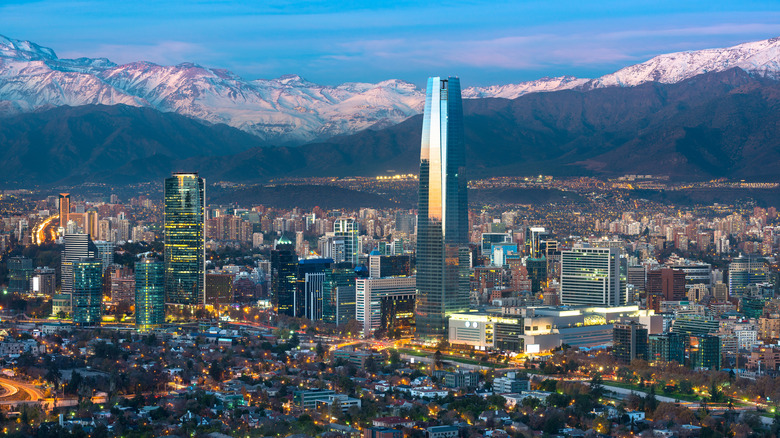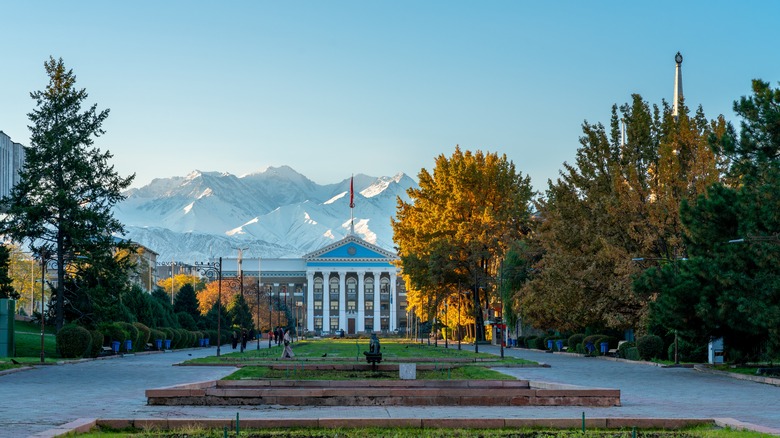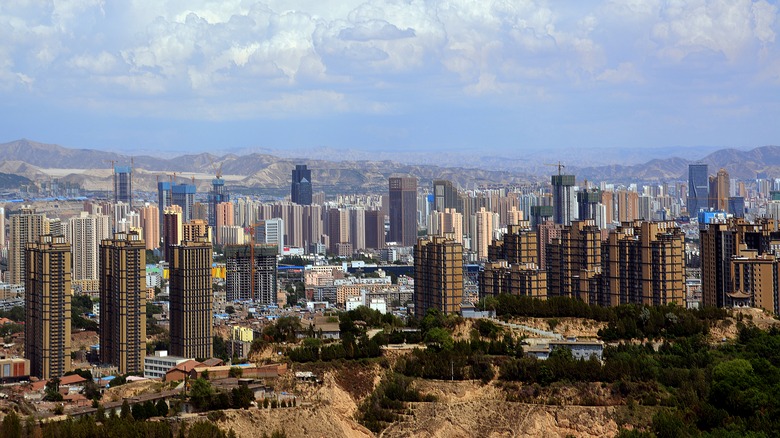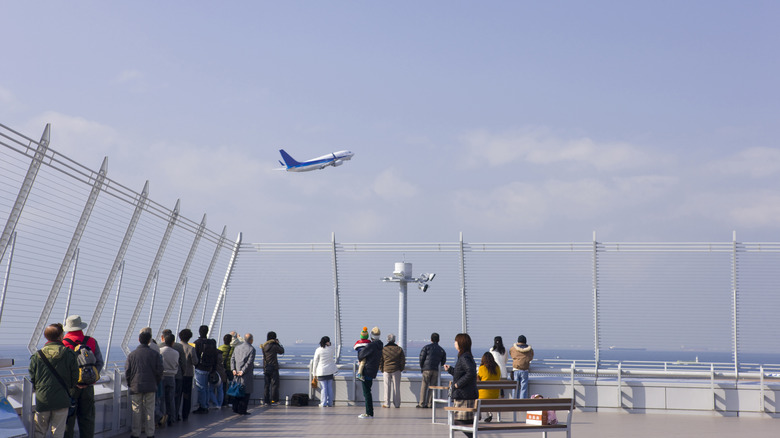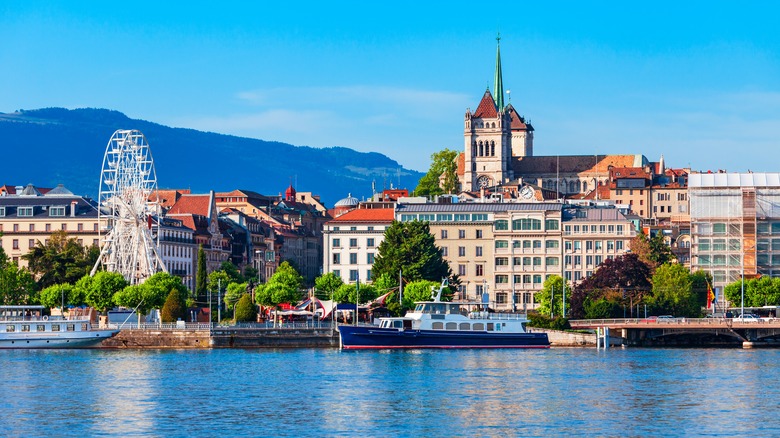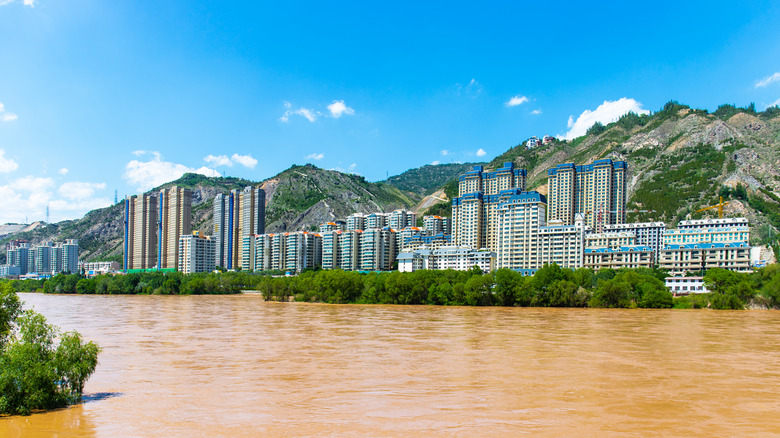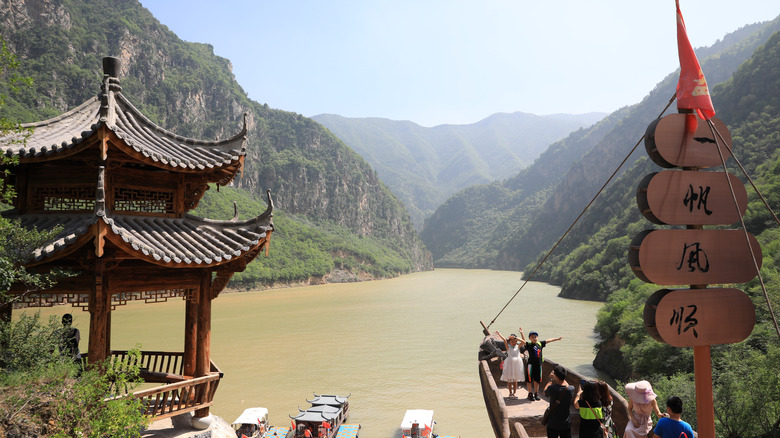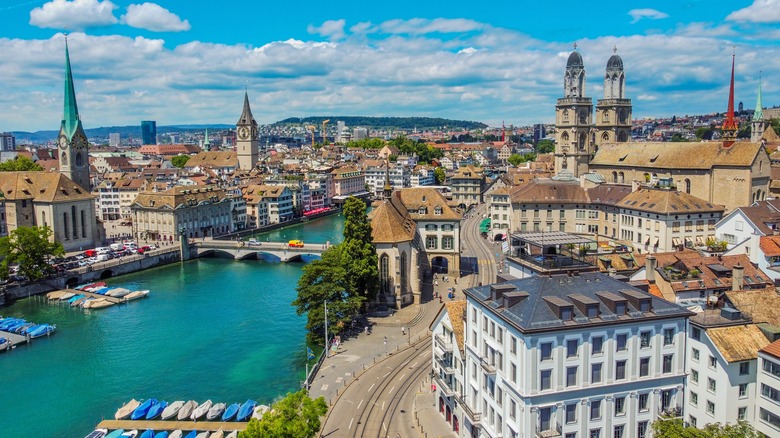These Flight Routes Are Proven To Have The Most Turbulence
For many people, flying is often the most challenging aspect of traveling, with approximately 40% of the U.S. population reported to have a fear of flying. This sense of unease is frequently heightened by turbulence during flights, leading to even more anxiety among passengers. Most of the time, however, turbulence is nothing to worry about — a minor hiccup in the journey through the skies. Yet, the discomfort it triggers is quite understandable, especially when passengers are unsure what to expect or what causes their plane's occasional shivers.
Despite the unsettling nature of turbulence, there is solace in staying well-informed and mentally prepared when encountering these aerial bumps. Acquiring knowledge about the various causes of turbulence and understanding in advance if certain flight routes are more susceptible to it can significantly contribute to peace of mind.
Turbli has revealed the most turbulent flight routes after analyzing a staggering 150,000 routes in 2023. Turbulence is measured in eddy dissipation rate (EDR), and in this study, a score between 0 and 20 means light turbulence, between 20 and 40 is considered moderate, between 40 and 80 means severe, and anything between 80 and 100 is extreme. Armed with this knowledge and some tips on how to mitigate the effects of turbulence, this article will (hopefully) help ease the anxiety and make air travel more enjoyable. Moreover, for those who harbor lingering concerns, we delve into convenient alternatives to flying these turbulent routes, providing thoughtful considerations for a more comfortable travel experience.
What causes plane turbulence?
Despite the discomfort it can cause, turbulence during flights is rarely an indication of imminent danger. The experience of the plane shaking or jolting is typically a result of encountering irregular or abrupt changes in air movement, influenced by various factors ranging from weather conditions to topography.
There are many majestic mountains in the world, but their towering peaks and rugged terrain exert a considerable impact on air flows. When a steady stream of air encounters a mountain range, it is forced upwards, disrupting the air movement around the aircraft. Thermal conditions also contribute to turbulence, particularly as the sun heats the Earth's surface. The ground absorbs and radiates heat, warming the air directly above it and forming pockets of warm air that pose a risk of turbulence when aircraft traverse through these areas. This effect is notably heightened in mountainous regions with taller surfaces. As you will see, most of the routes in this list traverse a significant proportion of mountainous regions.
Weather conditions such as thunderstorms and cloud formations are additional factors that contribute to turbulence. Furthermore, the presence of jet streams, which are fast-flowing air currents in the Earth's atmosphere that move from west to east. These currents form due to temperature and pressure differences between the Earth's poles and equator. Jet streams, with speeds exceeding 100 mph, can induce turbulence for aircraft flying through or near them.
Santiago (SCL) - Santa Cruz (VVI)
A direct flight from Chile's Santiago to Bolivia's Santa Cruz covers a distance of 1,194 miles and typically takes only three hours. However, the availability of this route is limited, with LATAM Airlines offering just one direct flight per week, usually on Tuesday mornings. Other airlines may involve at least one layover, extending the total travel time to up to 27 hours. Some routes may even detour further north to countries like Colombia or Nicaragua before heading back south to Bolivia's largest city.
Despite the relatively short distance of the direct flights from Santiago to Santa Cruz, the journey traverses the formidable Andes mountain range. The Andes, characterized by towering peaks and rugged topography, create intricate, atmospheric conditions and dynamic air currents that can result in turbulence during the flight. The database recorded this route's average turbulence score at 17.568 EDR, making it the route with the highest average turbulence in 2023. Bumpy? You bet.
Indirect flights from Santiago to Santa Cruz may take considerably longer but come with less turbulence and more flight options. Alternatively, a bus journey from Terminal Alameda in Santiago to Santa Cruz takes about 40 hours, or you can opt for an overland multi-day tour, which not only provides a scenic route but also takes you through captivating natural attractions between the two cities.
Almaty (ALA) - Bishkek (FRU)
Almaty is the largest metropolis in Kazakhstan, renowned for its fusion of modern urbanity and natural beauty. Meanwhile, Bishkek is the capital city of Kyrgyzstan and a vibrant cultural hub adorned with Soviet-era legacies. Despite belonging to different countries and cultures, these charming cities share a geographical trait. They are both nestled on the foothills of the Tien Shan mountains, a massive range that sprawls across Central Asia. This topography contributes to the turbulence experienced by aircraft flying along the mountainous route, disrupting wind patterns as they navigate the dynamic atmosphere. According to the data, the flight from Almaty to Bishkek has an average turbulence of 17.457 EDR, the second-highest on the planet and the highest in Asia.
A direct flight from Almaty to Bishkek lasts merely 50 minutes with Air Astana, covering a distance of only 131 miles. Besides Kazakhstan's flag carrier, other airlines offer only indirect flights involving layovers that can bring the total trip up to seven hours or more. Travelers can also opt for the bus road trip, which takes about five hours, winding through picturesque landscapes and charming little towns along the way.
Lanzhou (LHW) - Chengdu (CTU)
Lanzhou is a bustling city in China situated along the Yellow River, known for its rich history, vibrant culture, and the iconic Zhongshan Bridge. Chengdu, on the other hand, is a modern metropolis famed for its spicy cuisine and giant panda conservation center. Despite being 410 miles apart in flight distance, both cities share the backdrop of mountainous landscapes, creating breathtaking cityscapes but also presenting a dynamic terrain to navigate.
The flight route from Lanzhou to Chengdu takes passengers through the vast and varied landscapes of western China. As the aircraft departs Lanzhou, the route skirts around the Qinling Mountains that stretch across central China, a significant geographical divide that influences climate patterns and harbors diverse ecosystems. Then, the journey encounters the eastern edge of the Tibetan Plateau, characterized by high elevations and rugged mountains. The intricate topography, interacting with the steady airflow, can lead to the formation of turbulence-inducing mountain waves, resulting in an average score of 16.75 EDR in Turbli's database.
As an alternative to the short flight from Lanzhou to Chengdu, travelers can opt for the high-speed train to Chengdu East, a journey that takes about seven hours.
Centrair (NGO) - Sendai (SDJ)
The journey begins at Chubu Centrair International Airport, Japan's fourth most important international airport. The airport is perched on an artificial island in Ise Bay, a picturesque coast just a short drive south of Nagoya. The flight takes a northeast direction toward Sendai Airport in Miyagi Prefecture, a region celebrated for its natural beauty and culinary delights.
The flight route passes over diverse landscapes, most notably the Japanese Alps, a majestic mountain range that bisects the Japanese archipelago. As the aircraft traverse these mountainous areas, they may encounter airwaves and turbulence due to the interaction between steady air and rugged surfaces. Both Centrair and Sendai airports are nestled along the Pacific coast on the eastern side of Japan, so it's also possible that the sea breeze could contribute to some atmospheric changes leading to turbulence. According to Turbli's data, the flight from Centrair to Sendai has an average turbulence score of 16.579 EDR.
This flight route covers around 322 miles in just over one hour. An alternative option to flying is taking the train from Nagoya to Sendai via Tokyo, extending the trip to around five hours.
Milan (MXP) - Geneva (GVA)
The flight from Milan to Geneva has the highest turbulence rating of any European route in this list. To make the journey, the plane must traverse the mountainous Alpine region. Flying over the Alps has proven to be challenging and susceptible to turbulence due to the mountain waves created when air is forced to ascend over its rugged peaks. Additionally, the Alpine region is prone to the development of lee waves, which are currents forming on the lee side of a mountain range, contributing to atmospheric disturbances that may cause turbulence. Turbli's data shows that the average turbulence score for this flight route is 16.398, the fifth highest in the world.
An appealing alternative to the Milan to Geneva flight is train travel. One might even argue that it's a better option, considering the journey only takes between four and six hours (depending on the train), and passengers have the opportunity to savor the breathtaking Alpine scenery as the train passes through Lake Maggiore, Lake Geneva, countless charming towns and sweeping vineyards.
Lanzhou (LHW) - Xianyang (XIY)
This marks the second appearance of Lanzhou in this list, underscoring the significance of the city's dynamic topography and its impact on flight turbulence. Lanzhou is surrounded by the Qilian Range, Mount Pingliang, and Mount Kongtong, the latter a hugely significant mountain in Taoism. On the other end of this flight, Xianyang is an iconic ancient city boasting a rich historical heritage, best known for its Terracotta Army.
Direct flights from Lanzhou to Xianyang are operated by China Eastern Airlines once daily, completing the journey in one hour and 25 minutes. The route traverses the northwestern part of China, encompassing diverse landscapes of mountainous terrain and arid plains before reaching Xianyang. Furthermore, it is thought that high jet stream activity is a factor influencing increased turbulence in flight routes across China and Japan. In 2023, the average turbulence score for this route was recorded at 16.337 EDR. Alternatively, a train journey from Lanzhou West Station to Xi'an North Station in Xianyang takes a little over four hours with high-speed trains.
Osaka (KIX) - Sendai (SDJ)
Flying from one coastal city to another along the eastern coast of Japan, this route isn't a million miles away from the Centrair to Sendai route mentioned earlier. The journey begins in Osaka, Japan's second-largest metropolitan, renowned for its lively street food scene and distinctive architecture. Over a flight distance of 407 miles to the northeast, the aircraft arrives at Sendai after a travel time of one hour and 20 minutes.
The Osaka to Sendai route crosses diverse terrains, including the Japanese Alps, a mountain range that cuts through the Japanese archipelago. As the aircraft flies over these mountainous regions, it may encounter airwaves and turbulence. Additionally, both airports could also be affected by sea breezes, potentially leading to atmospheric shifts and turbulence. Furthermore, the route falls within the area influenced by the force of jet streams, further affecting atmospheric conditions. These conditions combine to create an average turbulence score of 16.307 ED.
A sensible alternative to taking the flight is opting for a train journey using the Japan Rail Pass from Shin-Osaka Station to Sendai via Tokyo, for a total travel time of four hours and 30 minutes.
Xianyang (XIY) - Chengdu (CTU)
Both Xianyang and Chengdu have appeared previously on this list as destinations of routes with notable turbulence, holding the sixth and third positions, respectively — further cementing the significance of China's mountainous geography and jet streams as a contributor to turbulence. One potential cause of turbulence on the Xianyang to Chengdu flight route is the proximity to the Qinling Mountains, a major mountain range spanning central China. As the aircraft departs from Xianyang, turbulence may be encountered near mountain passes or as it maneuvers through the undulating air currents interacting with the rugged mountain topography. Additionally, the route contends with jet streams flowing west to east, adding further dynamics to the atmospheric conditions. The database gives this route an average turbulence score of 16.25 EDR, the third highest in China and eighth globally.
Direct flights from Xianyang to Chengdu have a duration of approximately one hour and 55 minutes, with multiple flights departing daily by several airlines. Alternatively, travelers can board the high-speed China Railways train from Xi'an North to Chengdu East, completing the journey in about four hours.
Xianyang (XIY) - Chongqing (CKG)
It's now official that Xianyang holds the record for the most mentions on this list. This time, the spotlight is on the route from Xianyang to Chongqing, a sprawling megacity along the Yangtze River surrounded by the Daba, Wushan, and Wuling mountains. Chongqing earns its moniker as the Mountain City due to its dramatic and striking topography, reflected in unique architecture and city planning that works in harmony with the hilly landscape.
Similar to other routes in China mentioned in this list, the rugged topography of central China, particularly the Qinling Mountains, is a possible contributor to turbulence. Jet streams may also play a role in the atmospheric dynamics. In 2023, the average turbulence score for this route was 16.041 EDR. Multiple airlines operate this route, covering a distance of 348 miles in just one hour and 25 minutes. As an alternative, travelers can opt for the China Railways high-speed train from Xiangyang East to Chongqing North Station, a trip that will take approximately two hours and 50 minutes. Unless you are a glutton for turbulence, of course.
Milan (MXP) - Zurich (ZRH)
The flight route from Milan to Zurich traverses the airspace between Italy and Switzerland, navigating the expansive Alps mountain range. As the aircraft departs from Milan, it encounters towering Alpine peaks, where the interplay of steady winds with the rugged topography can give rise to turbulence-inducing mountain waves. The variable weather conditions in the Alps can further enhance the potential for turbulence, as the aircraft may undergo rapid changes in temperature and atmospheric pressure as it enters and leaves the Alpine region. This is reflected in Turbli's average turbulence score for this route, which is 16.016 EDR.
The direct flight from Milan to Zurich has a brief duration of approximately 60 minutes, covering a distance of 127 miles. Comparatively, a train journey from Milan Centrale to Zurich Hauptbahnhof takes just over four hours. The journey has also been dubbed as one of the most scenic train routes in the world, promising breathtaking views of Alpine mountains, lakes, villages, and more along the way.
How to fly with less turbulence
Even when flying routes susceptible to turbulence, there are ways to enhance the smoothness of your flight. There's never a bad time to check the turbulence forecast, after all. Firstly, selecting the right times to fly can make a significant difference. Flying during the early morning or late evening has proven to be advantageous for minimizing turbulence, as the air tends to be smoother during these times. On the other hand, as the sun rises, the heating of the ground may cause warm air to rise, potentially interrupting the flight's smooth journey.
The choice of your seat on the aircraft can also impact your turbulence experience. Seats positioned over the wings tend to feel more stable, with passengers experiencing less motion, thanks to the balancing effect of the plane's wings. Furthermore, the seats located towards the front of the aircraft generally experience fewer disturbances compared to those at the rear. Additionally, bigger planes can generally handle turbulence better because the bigger mass is less susceptible to wind changes.
Different seasons can also affect the susceptibility of turbulence. Unfortunately, the holidays are often peak time for air turbulence. The winter's blizzards and the summer's strong winds can contribute to unstable air currents. Lastly, it's always a good idea to check weather forecasts for both your departure and arrival prior to the flight. This way, you can stay informed and choose dates with more stability, avoiding potential disruptions such as thunderstorms or snowfall.
What to do during turbulence
Despite the best preparation, turbulence remains an unpredictable yet natural part of air travel. When it occurs, understanding how to navigate these moments is crucial for maintaining comfort and peace of mind during flights. While the initial response to turbulence might be anxiety, it's essential to remain calm and trust the flight crews, who are trained and well-prepared to handle these occurrences safely. Listening to their announcements and diligently following their instructions will contribute significantly to your peace and safety.
The most critical safety measure during turbulence is to stay securely seated with your seatbelt fastened, even when the seatbelt sign is off. This precautionary measure helps protect you from potential injuries and allows you to remain in your seat during unexpected bumps. To keep calm, you can engage in activities to distract yourself from the turbulence, whether listening to music or watching an in-flight movie. You can also try slow, deep breaths in and out to manage anxiety.
Recognizing turbulence as a routine aspect of air travel and adopting these safety measures allows you to navigate these moments more comfortably. By staying informed, adhering to safety protocols, and employing calming techniques, you can enhance the overall in-flight experience, even during moments of turbulence.


